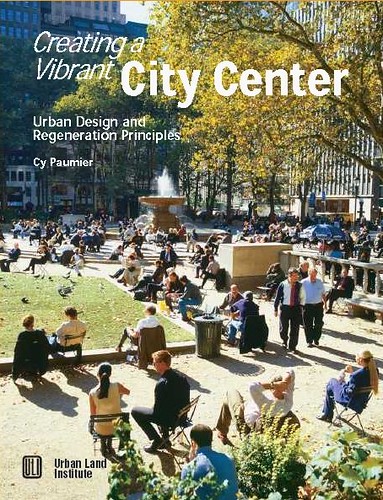The principles of intensification are pretty much the same for suburban and urban contexts
In line with the previous posting reprinting some of my musings about the difference between caring about and being focused on your house as opposed to simultaneously also being concerned about your community and the principles of successful communities as opposed to making your house great, NZ correspondent Nigel calls our attention to this article, "Density's next frontier: the suburbs," discussing the seemingly new phenomenon of intensification in the suburbs.
Nigel writes:
I think there are different density patterns for cities ... where land is scarce due to geographical constraints, the cities will be denser. Detroit will probably have low density for many years to come. I wonder about Richard Florida's wisdom in using only one city as his case study.I responded (now amplified and expanded):
your point about density... the great transportation planner Ian Lockwood once said to me, looking out at the mountains around Salt Lake City from the top of the Library (the green roof there is open to the public), "the best cities are constrained."
Yes, Detroit and Baltimore have the same problem. Too much latent capacity in the suburbs, and the lack of a quality intensification mechanism (transit) to bring commerce and people back to the city.
 Anyway wrt "the suburbs" ... anyplace where demand is high and supply of land and real estate development opportunity is constrained, they intensify.
Anyway wrt "the suburbs" ... anyplace where demand is high and supply of land and real estate development opportunity is constrained, they intensify. Nothing particularly unique about it. And it's been happening for 70 years!
Just that people too easily say city dense, suburbs not dense, without looking at the underlying phenomenon.
Cy Paumier outlines that phenomenon in Creating a Vibrant City Center and how the pattern of downtowns (central business districts) developed around pedestrian-scaled streets, blocks, and buildings because of:
Concentration and Intensity of Use: "The intensity of development in the traditional central area was relatively high due to the value of the land. Maximizing site coverage meant building close to the street, which created a strong sense of spatial enclosure. Although city center development was dense, construction practices limited building height and preserved a human scale. The consistency in building height and massing reinforced the pedestrian scale of streets, as well as the city center's architectural harmony and visual coherence." (p. 11)The street grid, transportation practices and construction technology of the times, and the cost and value of the land led to a particular form of development on city blocks that focused attention on the streets and sidewalks, creating a human-scaled, architecturally harmonious built environment.
Organizing Structure: "A grid street system, involving the simplest approach to surveying, subdividing, and selling land, created a well-defined, organized, and understandable spatial structure for the cities' architecture and overall development. Because the street provided the main access to the consumer market, competition for street frontage was keen. Development parcels were normally much deeper than they were wide, creating a pattern of relatively narrow building fronts that provided variety and articulation in each block and continuous activity on the street." (p. 12)
As construction technology advanced and taller buildings could be constructed, and as the walking and transit city was supplanted by the automobile, the scale of block development changed significantly, with a focus away from the pedestrian and towards the car.
The whole Edge City phenomenon (written about in the 1990s) "merely" describes this phenomenon as it relates to suburban centers in the automobility context.
Note that I spar intellectually with the writings of Joel Kotkin. He always writes that the urban revitalization phenomenon is flawed or a flash in the pan, that suburban development is transcendent. He misses the point as I used to.
Intensification is the issue. While it's a lot harder to do cool stuff in suburban locations for different reasons--people choose to live in the suburbs because they aren't seeking out cosmopolitanism, the conditions that lead to intensity are phenomena not limited to center cities.
There's cool stuff outside of center cities, in towns, suburbs, rural areas, etc. You may have to look harder to find it, but you shouldn't close your mind to it.
Anyway, when I first got involved in this stuff, the Urban Land Institute was publishing various "Ten Principles" guides to urban and suburban redevelopment, and while the first one I read was about revitalizing urban retail, as I read others as they were published I thought that the "suburban specific" publications were equally as informative as the urban and transit publications.
That's because the underlying point of all the publications was the same: (1) intensify; (2) plan in an integrated fashion; (3) use sound urban design principles.
Frankly, if you only have the time to read a few publications about the principles of revitalization, equally applicable to urban or suburban contexts, these ULI publications are evergreen!
-- Ten Principles for Reinventing America's Suburban Strips, 2001
-- Ten Principles for Reinventing Suburban Business Districts, 2002
-- Ten Principles for Rebuilding Neighborhood Retail, 2003
-- Ten Principles for Successful Development Around Transit, 2003
-- Ten Principles for Successful Public-Private Partnerships, 2005
-- Ten Principles for Rethinking the Mall, 2006
-- Ten Principles for Developing Successful Town Centers, 2007 (this is a download, not a viewable, link) -- Ten Principles for Building Healthy Places, 2013
Labels: real estate development, suburban revitalization, urban design/placemaking, urban revitalization




0 Comments:
Post a Comment
<< Home